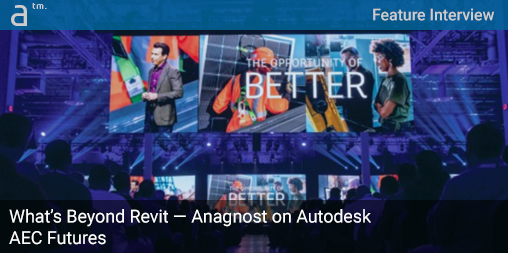THIS ARTICLE IS ONE OF THREE FEATURES THAT discuss the topics and issues that lead up to and beyond the Revit Open Letter movement initiated in the United Kingdom. Recently, Architosh had the opportunity to talk to Autodesk CEO Andrew Anagnost about the open letter and fill in some of the gaps behind the concerns and consternation among those in the AEC industry—about Revit’s future.
While the other features focus on framing the predicament and re-lensing AEC futures, respectively, this article will look at Autodesk’s response—not just to all Revit architect users, but more broadly, those wishing to understand the company’s AEC vision.
Introduction
When Anagnost agreed to take my call, I framed it as an opportunity to look beyond this present moment. The one thing that readers should be aware of is that Autodesk wasn’t surprised by the open letter. “We knew there was tension in architecture, and so we had already allocated more resources for Revit development on architecture months ago—nine to twelve months ago,” says Anagnost.
He assured me that Revit architecture users should expect some key announcements, many speaking to more innovation in Revit for the architecture market. What follows are highlights from our hour-long conversation about Revit and its future, what lies ahead in the near and long term.

Andrew Anagnost, President, and CEO, Autodesk, spoke to Architosh in detail about the future of Revit and AEC software a few weeks after the Revit open letter emerged. (Image: Autodesk / Architosh. All rights reserved)
An explanation to the reader. My conversation with Anagnost was deep, and we covered a lot of ground. We are going to overview much of that terrain below. As we run through it, I will be making notes of where the reader can find more in-depth material slated to be published in our Xpresso newsletter next month.
Interop 101 — IFC and Files
We start with interoperability because it was not just one of the main issues of concern in the open letter but because it is the linchpin topic in the future of AEC technology. The architects in the open letter expressed and want a better commitment to IFC, an area where Anagnost admits they lag.
Do we desire to do a better job with IFC? Absolutely! Is IFC going to solve the ecosystem’s problems? Absolutely not!
“Do we desire to do a better job with IFC?” Anagnost asks rhetorically, “Absolutely! Is IFC going to solve the ecosystem’s problems? Absolutely not!”
Autodesk is committed to IFC, but as Anagnost explained, it is far from being the whole or final answer to data interoperability and data exchange for the AEC industry. The company is actively working on those technologies.
“I’m a veteran of the data interoperability wars in the era of product design and engineering industry,” he says. “This is something I’ve watched play out in an industry that is much more digitally mature than AEC. And I think one thing we can all acknowledge right now—intermediate file formats are a temporary hack.”
But not just file formats like IFC, but “files” themselves are on the cutting block when it comes to the AEC industry’s future. “I think there is something we need to acknowledge right now,” he says, “that a file is a dead thing working.”
Interop and API
It is not that “files” are going away anytime soon, any more than how electric vehicles are forcing gas-based cars to disappear. Those transitions take place over decades. But the thing that was exciting to hear from Anagnost is the recognition that files are not the end game in AEC’s future.
Interop’s new dancing partner in AEC is the “API,” and the “file” is heading to the punch bowl where it will grab a drink and take a seat and be a much less frequent dancer. To make this metaphor clearer, out on the dance floor today are a bunch of files—many Revit files and a fair amount of IFC files holding hands and trying to be good partners. But the music is changing and dramatically—thanks to new technologies as we advance cloud and mobile device technology.
“It’s funny that you sent me the link on the people working on the AEC Delta Mobility project,” says Anagnost. “That’s the kind of stuff we are working on behind the scenes with Forge, this notion of both data APIs and data workflows.” Forge is Autodesk’s cloud-based developer platform. It enables both advanced users with software chops and third-party developers to build out focused digital tools that can visualize 3D models and data together and talk to Autodesk software products.
Interop and Manufacturing
Anagnost didn’t paint a super detailed picture of his statement about Forge and data APIs. However, the AEC Delta project reference suggests he means that data APIs can move specific parts of BIM models data from “digital tool” to “digital tool” without relying on sending whole Revit files or IFC files.
He also contends that part of the Quantum Project vision from its earliest stage was this very idea that APIs can enable tools to talk to each other, passing data around without the need for files. In early examples of Quantum, an architect could pass his curtain wall design to a curtain wall manufacturer and create a feedback collaboration loop speeding up the process that generally amounts to engineering review, shop drawings for scope conformity, and constructability pre-flighting. That Quantum vision addresses how manufacturing and AEC become linked.
Fusion has a file, but it also has what is called a ‘product information model’ under it, which sounds like a ‘building information model’ but right now, a building information model has a one-to-one correspondence with a file.
Anagnost contends that Autodesk today possesses much of the templates needed for AEC’s transformation. “In terms of getting a glimpse of where we are going in AEC,” he suggests, “you might want to take a look at what we have done in manufacturing.”
That’s an industry on the other side of its transformation, including tools and operational workflows. Anagnost is suggesting to look at Fusion, its modern mCAD application. Without getting into the weeds on the details of how Fusion influences Revit, Anagnost suggests that Fusion as a kind of “thick client” application represents how Revit may adapt to meeting the future needs of architects as well as other AEC players.
Advertisement
“Fusion has a file, but it also has what is called a ‘product information model’ under it, which sounds like a ‘building information model’ but right now, a building information model has a one-to-one correspondence with a file. That’s not true in Fusion-land,” he says. Fusion is different than Revit in many ways, but that product information model sits in the cloud “between the file and the application,” he adds.
The relationship between AEC and manufacturing, between Autodesk’s tools in each space, and how they may impact and influence each other is something to unpack in our follow-up article. The big takeaway from this comparison between Fusion and Revit is that the latter may get supplemented by new AEC tools that look like the former, and they will talk to each other.
next page: Revit Futures




Reader Comments
[…] “I’m a veteran of the data interoperability wars in the era of product design and engineering industry,” he says. “This is something I’ve watched play out in an industry that is much more digitally mature than AEC. And I think one thing we can all acknowledge right now—intermediate file formats are a temporary hack.” Read all three features in the series on Architosh. […]
Comments are closed.